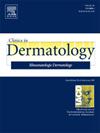正常薄片皮肤活检在评估全身/皮肤外疾病中的实用性。
IF 2.3
4区 医学
Q2 DERMATOLOGY
引用次数: 0
摘要
背景:不同病因引起的多器官血管损伤、周围神经疾病、自主神经功能障碍综合征和血管内淋巴瘤恶性肿瘤可能会在正常皮肤活检中表现出异常,这可能有助于确诊:我们对数据库进行了回顾性审查,以发现通过正常皮肤活检排除或排除某些系统性疾病(如补体驱动的血栓性微血管疾病,包括非典型溶血性尿毒症综合征)的病例、移植后血栓性微血管病、严重/危重 COVID-19、全身毛细血管渗漏综合征、脑常染色体显性动脉病伴皮质下梗死和白质脑病(CADASIL)、血管内 B 细胞淋巴瘤、自主神经功能障碍综合征和肥大细胞活化综合征。免疫组化染色包括 C5b-9、CD56、MXA、B 细胞和 T 细胞标记物:根据对某些参数的评估,包括评估三角肌区域 C5b-9 微血管沉积增加(非典型溶血性尿毒症综合征、移植后血栓性微血管病、灾难性抗磷脂抗体综合征和严重/危重 COVID-19)、I 型干扰素信号增强(系统性毛细血管渗漏综合征)、超微结构动脉病变(CADASIL)等,在确定诊断时存在一些关键的预期模式、下肢皮肤自主神经支配减少(小纤维神经病和 POTS),腹部、大腿和臀部皮肤活检发现血管内淋巴细胞(血管内 B 细胞淋巴瘤),弹性纤维发生明显的结构变化,支持假黄疽弹性瘤,肥大细胞密度高于正常值,但没有其他炎症细胞类型(肥大细胞活化综合征)。结论皮肤是了解疾病的重要窗口,临床正常皮肤的显微镜和超微结构检查可提示多种疾病,这充分体现了这一概念,因此正常皮肤活检是了解皮肤外疾病的重要工具。本文章由计算机程序翻译,如有差异,请以英文原文为准。
The utility of the normal thin section skin biopsy in the assessment of systemic/extracutaneous disease and small fiber neuropathy
Diseases reflective of multiorgan vascular injury of diverse etiology, peripheral nerve disease, dysautonomia syndromes, and intravascular lymphoma may exhibit abnormalities on a normal skin biopsy that may be instrumental in establishing a diagnosis. A retrospective review of our database was conducted to uncover cases where a normal skin biopsy was performed to rule in or out such systemic diseases as complement-driven thrombotic microvascular disease (including atypical hemolytic uremic syndrome, posttransplant thrombotic microangiopathy, and severe or critical COVID-19), systemic capillary leak syndrome, cerebral autosomal dominant arteriopathy with subcortical infarcts and leukoencephalopathy (CADASIL) intravascular B cell lymphoma, small fiber neuropathy, dysautonomia syndromes, and mast cell activation syndrome. Among the special studies were immunohistochemical staining to detect C5b-9, CD56, and myxovirus resistance protein A, as well as mast cell, B and T cell markers. Characteristic patterns were critical in establishing diagnoses such as : increased C5b-9 microvascular deposition in the deltoid area (atypical hemolytic uremic syndrome, posttransplant thrombotic microangiopathy, catastrophic antiphospholipid antibody syndrome, and severe or critical COVID-19); enhanced type I interferon signaling (systemic capillary leak syndrome); ultrastructural arteriopathic changes (CADASIL); reduced cutaneous autonomic innervation in the lower extremities (small fiber neuropathy and postural orthostatic tachycardia syndrome); presence of intravascular lymphocytes on biopsy of abdominal, thigh, and buttock skin (intravascular B cell lymphoma); and a higher than normal density of mast cells in the absence of other inflammatory cell types (mast cell activation syndrome). The skin is clearly a critical window for understanding extracutaneous disease, a concept well exemplified by the myriad of diseases suggested by the microscopic and/or ultrastructural examination of clinically normal skin and therefore establishing the normal skin biopsy as an important tool for understanding certain extracutaneous reactive, neoplastic and paraneoplastic syndromes as well as small fiber neuropathy.
求助全文
通过发布文献求助,成功后即可免费获取论文全文。
去求助
来源期刊

Clinics in dermatology
医学-皮肤病学
CiteScore
4.60
自引率
7.40%
发文量
106
审稿时长
3 days
期刊介绍:
Clinics in Dermatology brings you the most practical and comprehensive information on the treatment and care of skin disorders. Each issue features a Guest Editor and is devoted to a single timely topic relating to clinical dermatology.
Clinics in Dermatology provides information that is...
• Clinically oriented -- from evaluation to treatment, Clinics in Dermatology covers what is most relevant to you in your practice.
• Authoritative -- world-renowned experts in the field assure the high-quality and currency of each issue by reporting on their areas of expertise.
• Well-illustrated -- each issue is complete with photos, drawings and diagrams to illustrate points and demonstrate techniques.
 求助内容:
求助内容: 应助结果提醒方式:
应助结果提醒方式:


